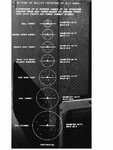A second question to be asked, particularly for wing mounts on an Fw 190, is why do we belive that the wings are 'stiffer' under high aero loads, to the point that the convergences are close to ground calibration?
Unless G's are being pulled there shouldn't be any difference than when firing on the ground, and they are more stable platforms, eventhough they undoubtedly vibrated to some extend when fire was commenced. Hence why the Zerstörres used to lob shells at the bombers out of reach from their defensive armaments.
And then there is again the fact that a bomber is a larger target which doesn't move all over the place, while a fighter is much smaller.
Now I have no argument with the fact that the gun mounts on bomber were stable and good platforms, infact I've had this debate before with Adler where I was the one argueing for them. But I also recognize its a different deal shooting at a stationary target on the ground and then have to shoot at a moving fighter from a bomber in the air.

